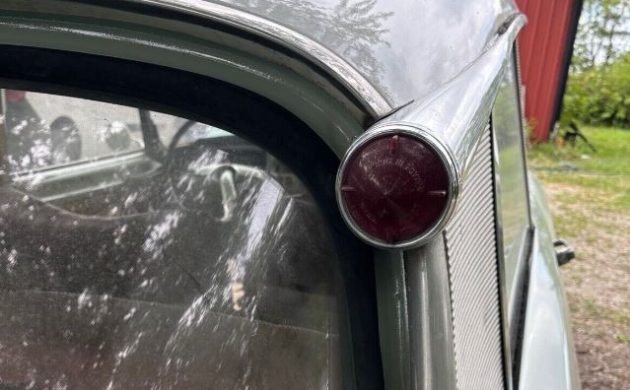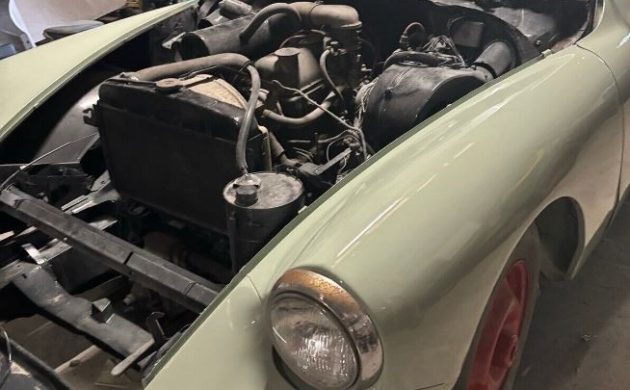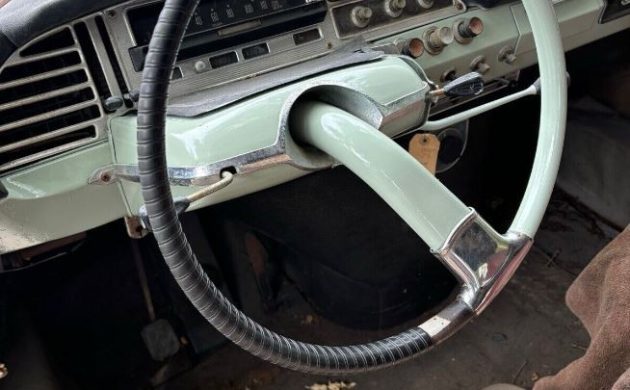André-Gustave Citroën was an exceptional innovator, stirring together inventions from other visionaries to create singular cars. Citroën himself was Dutch and Polish, but the family settled in Paris in 1873. Trained as an engineer, he made armaments during WWI. Once the war ended, his vast factories needed a new job, and Citroën settled on auto manufacturing. Into this mix dropped Flaminio Bertoni, arriving in Paris from his native Italy with a girlfriend in tow. Bertoni was fleeing the disapproval of his mother, who preferred that he marry a cousin. Enamored of automobiles and a skilled draughtsman, the young Italian was swiftly hired by Citroën, and it is his work we see in the sheet metal of the Traction Avant, the Deux Chevaux, and later, the DS. The fantastical DS is represented here by a 1964 version, located in Crete, Illinois. This car has been stored for over forty years but was given a recent paint job in factory colors.
The first DS hit the 1955 Paris Motor Show like a comet – a celestial thing that no one had even conceived before that moment. Its enveloped rear wheels were set closer together than the fronts, allowing for a nippy little tail. Its tapered headlight housings, sweeping hood, and generous, rear-pitched greenhouse declared “I’m French!” Mechanically it furthered Citroën’s hydropneumatic self-leveling suspension system. It had inboard front disc brakes, and a semi-automatic transmission. The only knock on the car was its rather ordinary 1911 cc inline four-cylinder engine, albeit equipped with an aluminum cross-flow head. Output was 75 hp. One year after our subject car was sold, engine displacement was increased to 1985 ccs, putting a few more ponies under the hood.
Our seller claims matching numbers on the engine and transmission. A heritage certificate confirming such details as well as trim, colors, and so forth, is available for DS cars as well as others, by applying here. The seller notes that the engine does turn.
The DS cabin is dominated by its single-spoke steering wheel and multi-color design scheme. Scanning the interior we find green-gold, tan, buff-white, the pale green of the exterior, and black. The front seats are tattered; the rears are better but shouldn’t be left out in a restoration – we all know how the rest of the car looks when only one component is renewed. The dash cover is cracked but all the gauges, switches, and trim are present. This car is for sale here on eBay, with an asking price of $7500. Notably, when I began writing this article, the price was $8500. Meanwhile, the market for DS cars expresses definite preferences: early cars can bring a premium; Pallas trim is considered desirable; later cars with larger engines will sell for more than early cars. Prices can range from four figures for project cars to more than $100k for special-bodied examples. Generally, though, these cars are accumulating a growing fan base, so if you fancy one, better get to shopping!





Not to quibble, Michelle, but this appears to be an ID19, an “economy” version that did away with, among other things, the “Citromatic” transmission. “Tells” for a former DS owner like me are the clutch pedal seen indistinctly in the interior photo (there should also be a brake pedal replacing the DS “mushroom”) and the location of the shift lever, which on DS cars sprouted from atop the steering column.
Even so, I still think the car is a pretty good deal, though knowing that a) it is a lower-spec car (less horsepower and lower-grade trimmings) and b) is going to need major repairs, replacements and refurbishment, particularly in the hydraulics, which don’t do well when unused for long periods.
Oh, and the stories I have heard about Flaminio Bertoni make more of his talent as a sculptor than skill with a pencil. It is said — and I don’t know if true — that the design process went from rough sketches right to a plaster model, which was then refined.
Michelle, you get all the cars that would fill my Dream Garage!
Thanks to everyone who has such granular knowledge of these lovely cars. I appreciate the addition to the knowledge base around here!
Here is a photo of the VIN supplied in the listing on eBay; I dunno, seems to say DS, but I also know a lot of these cars were changed in various ways, by pulling tags, engines, and whatnot over the years.
Indeed, this appears to be a DS, not an ID. If you zoom in on the interior photos showing the steering wheel, you can just barely see it has the brake “mushroom” button of a DS, rather than the more conventional brake pedal of the ID (which still operated a similar button, just tucked up under the dash).
DS cars were initially only available with the Citromatic semi-automated manual transmission (with a gear preselector lever on top of the steering column), but starting in ’63 were also made available with a conventional manual transmission having a clutch pedal and gear shift on the side of the column, as seen here.
Nice intro Michelle for this French world shocker. Well, for starters, interesting that the ad poster didn’t check the results after writing that the car has been “in shortage” for 40yrs! A shortage of care perhaps! And RayT is correct – the car is an ID19 – not the always semi-auto DS19. The generator is not present altho “parts” are mentioned as accompanying the car, but why no photos of those? Many of the black parts under hood appear to have gotten a shot of rattlecan black, yet the L front sphere is original rust! Looking at the front end, the air tunnel feeding cool air to the radiator is missing, and the front lower valence is shown being painted but not in place on the car.
The front chassis crossbar tying the front chassis horns together appears to have wandered right, as the bracket in place to guide the handcranks shaft into the transaxle nose is offset to the right which might mean the front end got whacked sideways during an accident – I’d sure want to check the alignment of those chassis horns. I’m guessing that the seller found this one in an estate sale & decided to make a quick buck by throwing some paint on it a la Earl Scheib’s approach yrs ago to make the car look more presentable, but the interior deterioration suggests a very close look at the chassis of any car “shorted” in Illinois for 4 decades is a must for any smart bidder if possible. Having had my own ID affected adversely by Ill. salted roads when a grad student there in the late ’60s and past Pres of the Chicago Cit club twice, beware the tinworm! And lift the carpets all the way to the chassis bottom and everywhere under the jute fiber chassis covers!
Been driving these Gaullic marvels since 1962, so know whereof I speak.
Say Ken. I have a ’75 Dyane that runs like crap. 115 compression after a recent rebuild. Chinese repla carburetor But get this will NOT throw a spark no matter what I do although spark test light shows a spark. Tried grounding a HT wire holding and a fresh plug out grounded. NOTHING! Replaced Coil points condenser, plugs wires numerous times NOTHING!. Cannot get a visual spark to jump even 5mm. Will start but plugs are gas fouled after 2hrs. running. Any idea? Used to belong to Central Citroen Club.
I’m no Citroen mechanic in particular, but in general principle it sounds like you might be missing a grounding strap/cable from the engine to the chassis?
Subgothius: Will certainly try. I did an ohm resistance body/chassis Result virtually zero resistance. But I’ll certainly follow up on your suggestion. Thanks ever so much
Richard, is the carb float needle valve letting too much gas into the bowl so it overflows into the Venturi while driving & enriches the mixture to foul the plugs? Or is a jet too big & runs it rich?
Two more details noted: The radiator hold-down bolts are missing, suggesting the rad. has just been put in position after a coat of paint. More significantly, the front crossbar ahead of the rad with the twisted crank hole is seriously out of alignment – as tho it was driven rearward near its left side attachment to the left front chassis horn, It should be parallel to the transaxle hanger tube which supports the radiator, and shows damaged areas that shouldn’t be there.
No doubt this car was in storage after it got an accident. a quick paint job to make it more presentable, and off it goes to Ebay. buyers be very carefull see it in real before buying. these cars are known to rust dramatically.
Don’t forget -in French, ID, pronounced e-day, means Idea. DS pronounced day-ess, means Goddess. Just all part of the Citroen mystique!
In the early 70s, I had a 1969 ID19. Thanks to its superb aerodynamics, that car, with its rather ordinary 1911 cc engine, would cruise very comfortably at a steady 100 mph – giving 30 mpg at that speed.
Subgothius: Will certainly try. I did an ohm resistance body/chassis Result virtually zero resistance. But I’ll certainly follow up on your suggestion. Thanks ever so much
Sold today for $6000.
Ken Nelson Hard to say on the carb it’s a Chinese clone. Will die at idle if mixture screw is turned in too far. Thanks so much for your input. As I said no visible spark when HT lead is almost grounded with screwdriver inserted or new plug to plug and plug grounded. NO VISIBLE SPARK although spark lamb shows one. Crazy. Stay tuned if you want to hear a grown man cry.